Join us the December as we take a dive into the weird and wonderful Will Eisner Spirit Archives, the DC collections of the comic strip that helped define the medium.
It’s hard to overstate the impact that Will Eisner had on comic books as a medium. The writer, entrepreneur and artist is known as “the father of the graphic novel”, with A Contract With God regard as one of te very first examples of the format. Eisner made massive in-roads into developing comics as a medium that merited discussion and attention, trying frantically to break out of the ghetto where the artform is so frequently trapped. While he has made countless pivotal contributions, arguably Eisner’s largest and most influential body of work can be found in The Spirit, the weekly comic strip that the author syndicated across America. Packaged with any number of respected newspapers, it was among the most widely-read comic strips in the country, but it also allowed Eisner the freedom to expand and develop his craft.
DC have collected the bulk of the character’s history in a series of their superb “Archive Editions”, from the first strip published through to Eisner’s last work on the title (with a supplementary volume published by Dark Horse). Here, in the first volume, we can see the artist honing his craft and developing the series into one of the most important in comic book history.
Early on, it becomes apparent that the content of the stories isn’t necessarily the most important or revolutionary aspect of what Eisner was doing here, at least this early on. Don’t get me wrong, these stories are highly readable. Indeed, they are among the most accessible of the “Golden Age” material, far easier to jump into than an old Batman or Superman issue. And Eisner shows a deft skill at storytelling. Each story in the volume clocks in at under eight pages, and there’s only one that could arguably be considered a two-parter.
It takes some skill to tell a complete story in eight pages, but Eisner manages. Sure, the characterisation might not be revolutionary, and the villains might be a tad one-dimensional. “I’ll be able to avenge myself on the Spirit,” one villain complains while staging his own suicide, “he represents good, and I, evil… ha ha!” Some of the plots don’t really hang together, and sometimes Eisner has to cover too much ground too quickly. That said, there’s an endearing briskness to the storytelling that works, with no story in the volume sticking around too long. While they won’t change the way you look at fiction, most are brief and satisfying romps.
Of course, one gets the sense that Eisner wasn’t especially interested in The Spirit or his world, at least not as far as genre conventions might go. As he admitted himself:
They wanted me to make a comic book for newspapers. At that time, it was a big risk! They gave me an adult audience and I wanted to write better things than super-heroes. Comic books were a ghetto. I sold my part of the enterprise to my associate and then began The Spirit. They wanted an heroic character, a costumed character. They asked me if he’d have a costume. And I put a mask on him and said, “Yes, he has a costume!”
Eisner’s storytelling is rather blunt, at least with the mandated superhero elements. The first supervillain, Dr. Cobra, is responsible for Denny Colt’s transformation into the Spirit. He dies in the second published strip. Later on, the villainess Black Queen appears three times, committing suicide in her jail cell during her third appearance.
That said, Eisner was perhaps quite a few years ahead of the superhero curve in one regard, the only true two-part adventure in this collection (Orang, The Ape Man) features a hyper-intelligent talking monkey, a comic book trope that would become a staple of superhero comics in the Silver Age. Eisner truly was ahead of his time.
Indeed, the Spirit himself seems like a parody of a superhero. Eisner had, of course, been caught up in a rather messy legal action concerning Wonder Man, and one can understand why the artist wasn’t especially happy to be pigeon-holed within the genre. Refusing to commit perjury, Eisner confessed that Bob Iger had instructed him to write Wonder Man as a clone of the highly-successful Superman in the middle of a very messy court case. So the Spirit seems like a paper-thin lead character with a few mandated nods towards superhero conventions.
His outfit is a plain blue suit, complete with a fedora. He doesn’t have any superpowers. He does have a ridiculous mask, which Eisner takes every opportunity to parody. The mask is impossibly expressive, and he never takes it off once he assumes the identity of the Spirit. Even in disguise, the mask always stays on, with Eisner contriving to hide it behind convenient glasses or under another mask or so forth. However, Eisner also takes great care to make sure that we can see the Spirit’s eyes behind the mask. While Batman might have seen the world through white slits in his familiar cowl, the Spirit seems infinitely more human with the character’s blue eyes always clearly visible.
All of this is grand, because it affords Eisner the chance to tell the stories that he wants to tell using the character, without being confined to standard superhero narratives. In fairness, Eisner does give Denny Colt a hint of character here, giving the hero the very slightest edge. Rather than operating strictly within the law, he blackmails crooks into giving money for school lunches. He doesn’t shut down mod casinos through conventional means, instead he bankrupts them. Hired to investigate a death threat, he refuses a salary. “I’ll take the case… you can give that $100,000 to charity! My only interest is to prevent crime!”
The character is delightful reckless in a way that only Golden Age comic book characters can be. In The Orphans, as part of the most absurd attempt to get through to children ever, the Spirit takes two runaways to a shoot-out in order to teach them that criminals are not cool. “Notice ?” he asks as bullets whizz past their heads. “As soon as danger threatens, they use their guns instead of their brains.” Personally, I noticed that he doesn’t tell them to get down.
Of course, morals do tend to get a little skewed in these hyper-condensed stories, especially when Eisner tries to be socially conscious. “Good luck, kid,” Dolan tells the title character in Johnny Marsten. “And remember, keep away from gambling, even when you’re in a jam!” Never mind the fact he won the money that way, and wouldn’t be able to take his wife to Arizona otherwise. Later on, a mad scientist makes some vague point about medical ethics that gets lost in a story about a hyper-intelligent gorilla. “What fools these so called scientists are! He was interested in Orang’s change but when his own daughter was changed, that was different! Bah! Fool!”
There are some slightly sinister undertones to the character though, if you look hard enough. It feels strange, now, to see a character so willing to give a woman a black eye. “I hate to hit a lady,” he insists as he punches out his second lady of the collection, “but you’ve had it coming!” Slightly more unnerving, however, is the implication in Prom that he serves as something of a clean-up guy for Commissioner Dolan. Dolan’s daughter, Ellen, claims there’s a body in her room. To avoid “a scandal”, Dolan sends the Spirit to take care of it. Hm.
Of course, these minor cultural differences are nothing when measured against the character of Ebony White, the Spirit’s “exclusive cabbie”, an African American youth rendered in the most stereotypical manner possible. He delivers cringe-worthy dialogue like “yassur!” and “does ah shoot him, Spirit?” and “please, boss!” While he’s portrayed as good-natured and loyal, he’s also something of a fool – convinced of the existence of ghosts (which the Spirit disproves in a matter of panels), inventing a stupid helmet to shield him from gunfire and getting duped into helping a gang of bank robbers.
A lot has been written about Ebony, with some commentators comparing The Spirit to Huckleberry Finn, and others… not so much. Far more educated and considerate authors have considered the character, and I think that each reader will have to make up their mind about how they feel about Ebony. Some readers won’t be able to read the book because they find the portrayal so offensive, and I think that’s a perfectly valid opinion to hold. I’m not grounded enough in American social history to contribute much to the debate, but even if you concede that the portrayal was “fair for its time” (and given that Sam in Casablanca was only a few years away, I find that a bit hard to believe), it doesn’t make it any easier to swallow. Enough about that.
The truth about The Spirit is that it afforded Eisner the opportunity to tell the stories that he wanted to tell, whatever they might be. So we get noir-themed mob adventures, socially-conscious moral fairy tales, international espionage, screwball romantic comedy and even a healthy dose of hokey science-fiction. In many ways, it feels like the Spirit was just a plot device to allow Eisner to write about whatever grabbed his attention at that moment in time.
Indeed, even in the first six months we can already see a number of strips where the Spirit is very much a background character in a story that belongs to others. In Johnny Marsten, Eisner seems much more focused on the eponymous character and his sick wife (whose story inspires the Spirit to tears) than on Denny Colt. The Spirit arrives on the scene too late to do anything in Orang, The Ape Man, where the plot seems to resolve itself. Slim Pickens and The Christmas Spirit of 1940 are both stories more focused on the criminals of the week than on the hero himself.
In fact, it seems that The Spirit was already working as more of a screwball romantic comedy than as a noir comic strip. That feels almost appropriate, given how much the Spirit resembles Cary Grant. The Kidnapping of Daisy Kay sees the character attempting a… creative resolution to the title’s love triangle. “Don’t worry, Homer,” he tells Ellen Dolan’s love-sick suitor. “Here’s a plan that never fails. I’ll kidnap her. You will come in and save her from me! You’ll be a hero and she’ll hate me!” Part of me wonders how adept the Spirit is at dealing with situations like this that he has figured out “a plan that never fails” that involves abduction and betrayal. (“Gosh, Spirit,” Homer replies, “you’re not such a bad guy at all!”)
Indeed, Eisner’s wonderfully light artistic style suits this sort of light-hearted comedy quite well. I especially love the goofy opening sequence from The Manly Art of Self Defense, with the Spirit literally fleeing Ellen’s advances, more terrified than Ebony has ever seen him before. It’s stories like that which feel much quirkier than the standard mob-themed plots, and I think that Eisner’s exploration of that rich off-kilter style would lead to much of the series’ distinctive appeal.
It’s interesting reading a weekly magazine, because you can get the sense of how quickly and subtly things can change and the focus can shift. In particular, reading this collection from June 1940 through to December 1940, one can easily see the Second World War looming in the background, getting increasingly closer. In fact, the Spirit’s decision to enter national service seems to foreshadow Will Eisner’s own wartime work, which would lead him to abandon the strip in a few short years. “Thousands of Americans are leaving comfortable jobs to aid in our defense,” the Spirit explains. “Why should I be an exception? Besides, I think there may be a place for the Spirit in the army.”
I wonder if Eisner’s Jewish background made him more sensitive to what was unfolding in Europe at the time. As early as October 1940, in The Spirit! Who is He?, you can see the artist trying to reposition his creation in opposition to the rise of fascism. As the newspapers try to make sense of who the Spirit might be, Commissioner Dolan explains, “He is the Spirit of Freedom. The Spirit that comes to the aid of the downtrodden, the weak and the helpless… He is the Spirit that destroys those who seek to enslave their fellowmen… Evil men who can twist the law to suit themselves…”
In fact, the last strip collected here, The Leader, sees Eisner make some fairly unsubtle attacks on Adolf Hitler, with a small and scrawny man left at the mercy of a big lumbering brute fighting for the last drop of water. The Spirit sits overhead, quoting from a book that might as well be Mein Kampf. “According to your own book… it says… when a country wants more land, it has the right to take it from a smaller one,” the Spirit boasts as the eponymous Leader is shown to be just a small frail man.
By the time we get to Dr. Prince Von Kalm, we’re told that, “one by one, the European countries fall under the plague of dictatorship…” The specter of war looms. As if trying to connect this story to the ones he has already told, Eisner has the Spirit describe the secret police as “political gangsters.” It’s telling that the secret police plan to keep the asylum seeker alive, so long as he agrees to use his artistic gifts to benefit them. “I will let you live,” the bad guy boasts, “only as long as you write propaganda for me!”
However, as pulpy and entertaining as the stories might be, they aren’t the really interesting and exciting aspect of the book. At least not yet. The real tangible joy of these early stories is seeing Eisner experiment with the form of these types of stories, as Eisner really defined what is and isn’t possible within the confines of comic book storytelling. Providing one of three introductions, Alan Moore is quick to point to this aspect of Eisner’s style:
“I can think of no one who has explored the possibilities of this infant medium so tirelessly and rewardingly, nor anyone who has so successfully managed to evolve a working vocabulary for the parts and functions of comic strip and the fascinating ways in which its mechanisms can be fitted together.”
All of that is true and fair. Eisner’s artwork bristles, and the stories all flow smoothly. Some of them look like they could have been written and drawn only a few years ago, rather than seven decades into the past. A lot of the storytelling tricks and devices Eisner developed here are still a core part of comic book storytelling, and you can see him playing with structure here.
There are panels within panels during the wonderful Johnny Marsten. The Black Queen opens with a newspaper panel in the background providing exposition, a trick Eisner would repeat to greater effect in The Spirit! Who is He? The shape and flow of the panels grows more organic over the course of the run, the structure more intricate and precise. In Mr. Midnight, the eponymous villain actually ends up supporting himself against the wall of the panels as he collapses, as if struggling for room to breath.
And then there’s Eisner’s wonderful title gimmick, which seems to fade in and out over the course of the collection. In The Black Queen’s Army, you can see the introductory text incorporated into the background scenery, a note pinned to a tree. The following week, in Mr. Midnight, the character is holding the “T” to steady himself. Other moments bend Eisner’s fictional world, providing more tools for the master storyteller – for examples, road signs provide handy exposition captions in Eldas Thayer.
You can even see the writer really beginning to play with long-form serialised storytelling, in something that would become a tool in the genre. Many early Golden Age adventures had difficulty maintaining internal consistency, while Eisner actually manages to play out several arcs over an extended period of time here. The conspiracy against the Spirit in Eldas Thayer eventually resolves itself in The Spirit! Who is He? The city’s elections are mentioned in Gang Warfare and provide a plot point in The Mastermind Strikes! They’re hardly the stuff of epics, but it’s a sign that the author is developing the storytelling tools that would define the medium.
And then there’s Eisner’s art style. The writer and illustrator claims that he wasn’t really influenced by the cinema of the time, but by the short stories he used to read. Michael Barrier argues that Eisner is more strongly defined by his literary influences:
“Of all the media,” Eisner said in the Panels interview with John Benson, “print has always been the most attractive to me. … There’s an intimacy in reading that to me transcends motion pictures.” In fact, Eisner understood, probably better than any other comic-book creator ever has, how different comics and film really are—in particular, how very differently they handle time.
Nevertheless, one can see a strong noir influence in his visual design:
True, Eisner’s so-called “human interest” stories may have been inspired by short story writers such as Ring Lardner or de Maupassant, and he may have learned about concision and architectonics from them — Eisner’s Spirit stories were always exquisitely structured — but all the most prominent iconography and idioms that Eisner juggled so exuberantly and transformed so expertly to the comics form come straight from the movies of the time. Barrier to the contrary, Crime, espionage, thrillers, and romantic comedy were the most important influence on Eisner’s approach to The Spirit.
In particular, for example, Eisner seems to borrow his visual cues from noir. He’s quite fond of silhouetting violence, rather than actually showing it. Consider, for example, Lupo killing his master in Voodoo in Manhattan, or even the final murder in Palyachi, The Killer Clown. Eisner tends to favour slightly askew angles for his action shots, evoking the emerging noir cinematography.
Of course, Eisner’s strips are really too colourful (literally and figuratively) to be truly considered part of the noir movement. There’s way too much light in his stories, with the Spirit’s distinctive bright blue suit and fedora. More than that, though, Eisner’s stories tend to celebrate life rather than to contemplate death. Of course, there are exceptions here, but the good guys generally win and most people end up happy.
Even the relatively bleak Johnny Marsten seems to subvert the conventions of noir. The eponymous character begins gambling to support his sick wife, and is then beaten. We next see him on the slab, a solid and cautionary tale. But wait! He’s faking it! He actually gets to keep the money and take his wife to Arizona! And the bad guys get locked away for a good long time! Everybody wins, right?
It’s also worth noting, finally, that Eisner is still growing and developing – both as a writer and an artist, but also as a creator of this fictional world. While most of the core cast is assembled here, the more iconic bad guys have yet to appear in the strip. The Spirit still operates out of New York (with the fourth chapter titled Voodoo in Manhattan and the Statue of Liberty visible in Dr. Prince Von Kalm), rather than Central City as he would shortly. There’s a sense, even six months into the strip, that Eisner is still shaping and molding this saga. And I’d be lying if I didn’t admit it was more than a little bit exciting.
There’s a tendency to write off these early stories as among the weakest of Eisner’s work on The Spirit. True connaisseurs will recommend the author’s post-War work as his finest contribution to the strip, and they’re probably right. But that doesn’t mean that there isn’t fun to be had here at the start of The Spirit. There’s nothing like watching an artist on the top of his game developing the tips and tricks that would help define an entire genre.
Filed under: Comics | Tagged: A Contract with God, alan moore, arizona, Bob Iger, Canada, comic book, comic strip, Comics, dc comics, Ebony White, Eisner, Eisner Award, Ellen Dolan, Homer, japan, North Carolina, Secret World of Arrietty, Spirit, Spirit (comics), Studio Ghibli, Terence McKenna, United States, Will Eisner |















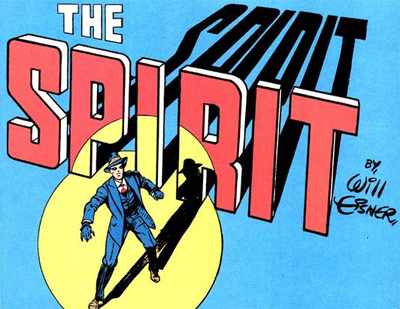

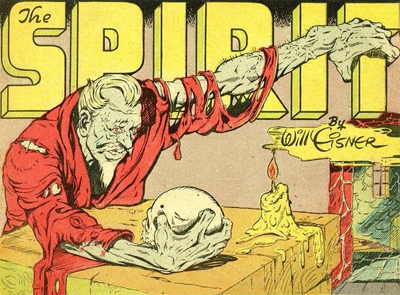





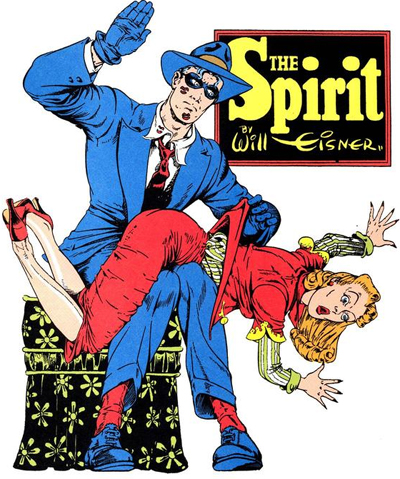



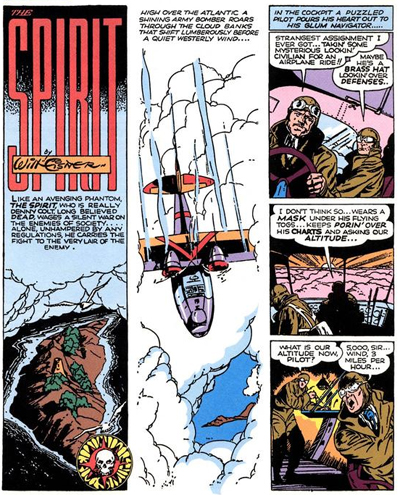

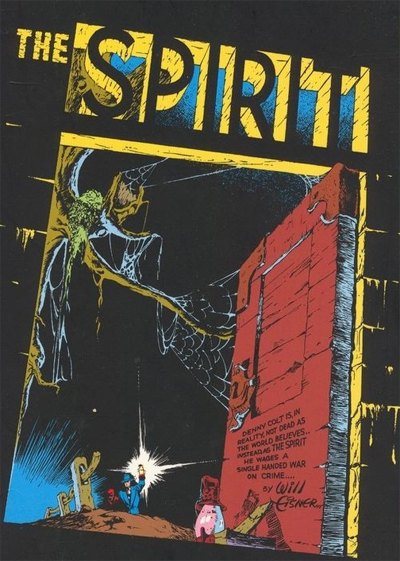






I’ll be the first to say the Golden Age is easily the weakest of all the main eras of the comics medium. But there is good stuff from the era. I rather like Marvel’s output from the period, along with Jack Cole’s Plastic Man, and those original Justice Society stories.